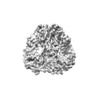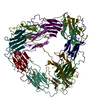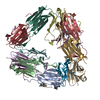+ データを開く
データを開く
- 基本情報
基本情報
| 登録情報 | データベース: EMDB / ID: EMD-30261 | |||||||||
|---|---|---|---|---|---|---|---|---|---|---|
| タイトル | Structure of Hsp21 | |||||||||
 マップデータ マップデータ | ||||||||||
 試料 試料 |
| |||||||||
 キーワード キーワード | small heat shock protein / CHAPERONE | |||||||||
| 機能・相同性 |  機能・相同性情報 機能・相同性情報chloroplast nucleoid / chloroplast organization / protein folding chaperone complex / response to light stimulus / response to heat / regulation of DNA-templated transcription 類似検索 - 分子機能 | |||||||||
| 生物種 |  | |||||||||
| 手法 | 単粒子再構成法 / クライオ電子顕微鏡法 / 解像度: 4.6 Å | |||||||||
 データ登録者 データ登録者 | Lau WCY | |||||||||
| 資金援助 |  香港, 1件 香港, 1件
| |||||||||
 引用 引用 |  ジャーナル: Nat Commun / 年: 2021 ジャーナル: Nat Commun / 年: 2021タイトル: Structural basis of substrate recognition and thermal protection by a small heat shock protein. 著者: Chuanyang Yu / Stephen King Pong Leung / Wenxin Zhang / Louis Tung Faat Lai / Ying Ki Chan / Man Chit Wong / Samir Benlekbir / Yong Cui / Liwen Jiang / Wilson Chun Yu Lau /   要旨: Small heat shock proteins (sHsps) bind unfolding proteins, thereby playing a pivotal role in the maintenance of proteostasis in virtually all living organisms. Structural elucidation of sHsp- ...Small heat shock proteins (sHsps) bind unfolding proteins, thereby playing a pivotal role in the maintenance of proteostasis in virtually all living organisms. Structural elucidation of sHsp-substrate complexes has been hampered by the transient and heterogeneous nature of their interactions, and the precise mechanisms underlying substrate recognition, promiscuity, and chaperone activity of sHsps remain unclear. Here we show the formation of a stable complex between Arabidopsis thaliana plastid sHsp, Hsp21, and its natural substrate 1-deoxy-D-xylulose 5-phosphate synthase (DXPS) under heat stress, and report cryo-electron microscopy structures of Hsp21, DXPS and Hsp21-DXPS complex at near-atomic resolution. Monomeric Hsp21 binds across the dimer interface of DXPS and engages in multivalent interactions by recognizing highly dynamic structural elements in DXPS. Hsp21 partly unfolds its central α-crystallin domain to facilitate binding of DXPS, which preserves a native-like structure. This mode of interaction suggests a mechanism of sHsps anti-aggregation activity towards a broad range of substrates. | |||||||||
| 履歴 |
|
- 構造の表示
構造の表示
| ムービー |
 ムービービューア ムービービューア |
|---|---|
| 構造ビューア | EMマップ:  SurfView SurfView Molmil Molmil Jmol/JSmol Jmol/JSmol |
| 添付画像 |
- ダウンロードとリンク
ダウンロードとリンク
-EMDBアーカイブ
| マップデータ |  emd_30261.map.gz emd_30261.map.gz | 39.8 MB |  EMDBマップデータ形式 EMDBマップデータ形式 | |
|---|---|---|---|---|
| ヘッダ (付随情報) |  emd-30261-v30.xml emd-30261-v30.xml emd-30261.xml emd-30261.xml | 15.4 KB 15.4 KB | 表示 表示 |  EMDBヘッダ EMDBヘッダ |
| 画像 |  emd_30261.png emd_30261.png | 33.8 KB | ||
| Filedesc metadata |  emd-30261.cif.gz emd-30261.cif.gz | 5.1 KB | ||
| その他 |  emd_30261_additional_1.map.gz emd_30261_additional_1.map.gz emd_30261_half_map_1.map.gz emd_30261_half_map_1.map.gz emd_30261_half_map_2.map.gz emd_30261_half_map_2.map.gz | 4.7 MB 40.6 MB 40.6 MB | ||
| アーカイブディレクトリ |  http://ftp.pdbj.org/pub/emdb/structures/EMD-30261 http://ftp.pdbj.org/pub/emdb/structures/EMD-30261 ftp://ftp.pdbj.org/pub/emdb/structures/EMD-30261 ftp://ftp.pdbj.org/pub/emdb/structures/EMD-30261 | HTTPS FTP |
-検証レポート
| 文書・要旨 |  emd_30261_validation.pdf.gz emd_30261_validation.pdf.gz | 620.2 KB | 表示 |  EMDB検証レポート EMDB検証レポート |
|---|---|---|---|---|
| 文書・詳細版 |  emd_30261_full_validation.pdf.gz emd_30261_full_validation.pdf.gz | 619.7 KB | 表示 | |
| XML形式データ |  emd_30261_validation.xml.gz emd_30261_validation.xml.gz | 11.9 KB | 表示 | |
| CIF形式データ |  emd_30261_validation.cif.gz emd_30261_validation.cif.gz | 13.8 KB | 表示 | |
| アーカイブディレクトリ |  https://ftp.pdbj.org/pub/emdb/validation_reports/EMD-30261 https://ftp.pdbj.org/pub/emdb/validation_reports/EMD-30261 ftp://ftp.pdbj.org/pub/emdb/validation_reports/EMD-30261 ftp://ftp.pdbj.org/pub/emdb/validation_reports/EMD-30261 | HTTPS FTP |
-関連構造データ
- リンク
リンク
| EMDBのページ |  EMDB (EBI/PDBe) / EMDB (EBI/PDBe) /  EMDataResource EMDataResource |
|---|---|
| 「今月の分子」の関連する項目 |
- マップ
マップ
| ファイル |  ダウンロード / ファイル: emd_30261.map.gz / 形式: CCP4 / 大きさ: 52.7 MB / タイプ: IMAGE STORED AS FLOATING POINT NUMBER (4 BYTES) ダウンロード / ファイル: emd_30261.map.gz / 形式: CCP4 / 大きさ: 52.7 MB / タイプ: IMAGE STORED AS FLOATING POINT NUMBER (4 BYTES) | ||||||||||||||||||||||||||||||||||||||||||||||||||||||||||||||||||||
|---|---|---|---|---|---|---|---|---|---|---|---|---|---|---|---|---|---|---|---|---|---|---|---|---|---|---|---|---|---|---|---|---|---|---|---|---|---|---|---|---|---|---|---|---|---|---|---|---|---|---|---|---|---|---|---|---|---|---|---|---|---|---|---|---|---|---|---|---|---|
| 投影像・断面図 | 画像のコントロール
画像は Spider により作成 | ||||||||||||||||||||||||||||||||||||||||||||||||||||||||||||||||||||
| ボクセルのサイズ | X=Y=Z: 1.06 Å | ||||||||||||||||||||||||||||||||||||||||||||||||||||||||||||||||||||
| 密度 |
| ||||||||||||||||||||||||||||||||||||||||||||||||||||||||||||||||||||
| 対称性 | 空間群: 1 | ||||||||||||||||||||||||||||||||||||||||||||||||||||||||||||||||||||
| 詳細 | EMDB XML:
CCP4マップ ヘッダ情報:
| ||||||||||||||||||||||||||||||||||||||||||||||||||||||||||||||||||||
-添付データ
-追加マップ: Sharpened and filtered map
| ファイル | emd_30261_additional_1.map | ||||||||||||
|---|---|---|---|---|---|---|---|---|---|---|---|---|---|
| 注釈 | Sharpened and filtered map | ||||||||||||
| 投影像・断面図 |
| ||||||||||||
| 密度ヒストグラム |
-ハーフマップ: #1
| ファイル | emd_30261_half_map_1.map | ||||||||||||
|---|---|---|---|---|---|---|---|---|---|---|---|---|---|
| 投影像・断面図 |
| ||||||||||||
| 密度ヒストグラム |
-ハーフマップ: #2
| ファイル | emd_30261_half_map_2.map | ||||||||||||
|---|---|---|---|---|---|---|---|---|---|---|---|---|---|
| 投影像・断面図 |
| ||||||||||||
| 密度ヒストグラム |
- 試料の構成要素
試料の構成要素
-全体 : Hsp21
| 全体 | 名称: Hsp21 |
|---|---|
| 要素 |
|
-超分子 #1: Hsp21
| 超分子 | 名称: Hsp21 / タイプ: complex / ID: 1 / 親要素: 0 / 含まれる分子: all |
|---|---|
| 由来(天然) | 生物種:  |
| 分子量 | 理論値: 250 KDa |
-分子 #1: Heat shock protein 21, chloroplastic
| 分子 | 名称: Heat shock protein 21, chloroplastic / タイプ: protein_or_peptide / ID: 1 / コピー数: 12 / 光学異性体: LEVO |
|---|---|
| 由来(天然) | 生物種:  |
| 分子量 | 理論値: 23.654545 KDa |
| 組換発現 | 生物種:  |
| 配列 | 文字列: MGSSHHHHHH SQDPNSENLY FQSAQDQREN SIDVVQQGQQ KGNQGSSVEK RPQQRLTMDV SPFGLLDPLS PMRTMRQMLD TMDRMFEDT MPVSGRNRGG SGVSEIRAPW DIKEEEHEIK MRFDMPGLSK EDVKISVEDN VLVIKGEQKK EDSDDSWSGR S VSSYGTRL ...文字列: MGSSHHHHHH SQDPNSENLY FQSAQDQREN SIDVVQQGQQ KGNQGSSVEK RPQQRLTMDV SPFGLLDPLS PMRTMRQMLD TMDRMFEDT MPVSGRNRGG SGVSEIRAPW DIKEEEHEIK MRFDMPGLSK EDVKISVEDN VLVIKGEQKK EDSDDSWSGR S VSSYGTRL QLPDNCEKDK IKAELKNGVL FITIPKTKVE RKVIDVQIQ UniProtKB: Heat shock protein 21, chloroplastic |
-実験情報
-構造解析
| 手法 | クライオ電子顕微鏡法 |
|---|---|
 解析 解析 | 単粒子再構成法 |
| 試料の集合状態 | particle |
- 試料調製
試料調製
| 緩衝液 | pH: 8 |
|---|---|
| 凍結 | 凍結剤: ETHANE |
- 電子顕微鏡法
電子顕微鏡法
| 顕微鏡 | FEI TITAN KRIOS |
|---|---|
| 撮影 | フィルム・検出器のモデル: FEI FALCON III (4k x 4k) 検出モード: COUNTING / 平均電子線量: 45.0 e/Å2 |
| 電子線 | 加速電圧: 300 kV / 電子線源:  FIELD EMISSION GUN FIELD EMISSION GUN |
| 電子光学系 | 照射モード: FLOOD BEAM / 撮影モード: BRIGHT FIELD |
| 実験機器 |  モデル: Titan Krios / 画像提供: FEI Company |
- 画像解析
画像解析
| 初期モデル | モデルのタイプ: OTHER / 詳細: ab initio from RELION 3.0 |
|---|---|
| 最終 再構成 | 想定した対称性 - 点群: T (正4面体型対称) / 解像度のタイプ: BY AUTHOR / 解像度: 4.6 Å / 解像度の算出法: FSC 0.143 CUT-OFF / 使用した粒子像数: 104126 |
| 初期 角度割当 | タイプ: MAXIMUM LIKELIHOOD |
| 最終 角度割当 | タイプ: MAXIMUM LIKELIHOOD |
 ムービー
ムービー コントローラー
コントローラー
















 Z (Sec.)
Z (Sec.) Y (Row.)
Y (Row.) X (Col.)
X (Col.)













































